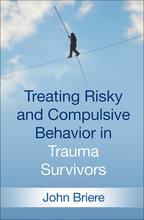Treating Risky and Compulsive Behavior in Trauma Survivors
John Briere
The reproducible materials can be downloaded and printed in PDF format.
1. Reactive Avoidance and Risky Behavior 
2. An Overview of Specific Distress Reduction Behaviors
3. Key Treatment Recommendations
4. Assessing Distress Reduction Behaviors in Context
5. Safety, Stabilization, and Harm Reduction
6. Acceptance and Mindfulness
7. Trigger Management
8. Processing Trauma- and Attachment-Related Memories
9. Treatment Planning and Implementation: Bringing It All Together
10. Special Considerations for Certain Distress Reduction Behaviors and Patterns
Conclusion
Appendix 1. Breathing Exercises
Appendix 2. Review of Distress Reduction Behaviors (Rev-DRB)
Appendix 3. Trigger Review (TR)
Appendix 4. Functions of Distress Reduction Behaviors (F-DRB)
Appendix 5. Triggers-to-Memories Worksheet (TMW)
Appendix 6. In-Session Emotional Regulation and Activation Scale (ERAS)
Appendix 7. ReGAIN for Triggered States
References
Index



